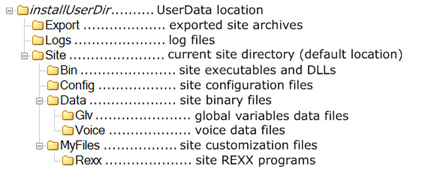The CA Automation Point installation program prompts you to supply the following:
For a new installation, the default installDir path is %PROGRAMFILES%\CA\CA Automation Point (%PROGRAMFILES(X86)%\CA\CA Automation Point on a 64-bit system)
For a new installation, the default installUserDir path is %ALLUSERSPROFILE%\CA\CA Automation Point.
System variables pointing to defined system folders (%var%) are present on all supported operating systems; however, their exact location may vary based on the version of the operating system and its settings.
Your current configuration and user files are located in the Site directory (referred to in this guide as siteDir). During installation of a new release, a shortcut to this directory is placed in the CA Automation Point folder in your Start menu.
Environment variables that point to the above-mentioned directories are created at installation time:
Following diagrams shows detailed directory structure:


Note that all CA Automation Point-distributed files reside in directories under the installation directory. The site-specific files you create reside in directories under the Site directory. Site folder subdirectories include the following:
Contains site-specific and customer-created CA Automation Point-related executables and DLLs. Executables and DLLs for product patches and test fixes should not be put in this directory.
Contains configuration files that you can modify using CA Automation Point tools. These include user interface layouts, the PPQ hosts file, the remote view hosts file, the session definition sets, and various binary files generated by Configuration Manager.
Contains site-specific and customer-created CA Automation Point-related binary files. The GLV subdirectory contains the data files used to store the values of non-volatile GLV variables. The Voice subdirectory contains voice files such as VOX files, voice library files, and voice files created during the execution of the Notification Manager component.
Contains customization files that you can modify using a generic editor. These files include rules files, script files, keyboard parameter files, scan code files, screen fonts files, menu files, and log format files. The REXX subdirectory holds site-specific REXX programs.
Other directories that have a fixed location under installUserDir are as follows:
Contains various output log files and log files moved from previously exported sites (in separate subfolders)
Contains exported site configuration archives and a backup of the current site configuration archive (created automatically before any import operation is performed).
| Copyright © 2012 CA. All rights reserved. |
|